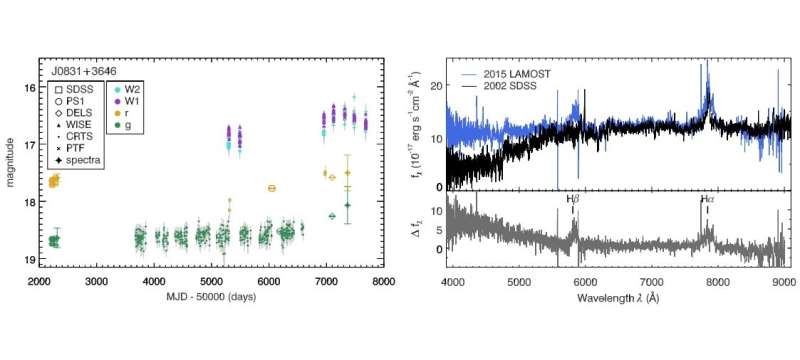November 28, 2017 report
Astronomers discover 21 changing-look active galactic nuclei

(Phys.org)—A group of astronomers led by Qian Yang of the Peking University in Beijing, China, has detected 21 active galactic nuclei (AGN) of a rare type known as changing-look AGNs. The finding, reported November 22 in a paper published on arXiv.org, doubles the number of such objects known to date and could improve our understanding of evolution of AGNs.
An AGN is a compact region at the center of a galaxy, more luminous than the surrounding galaxy light. They are very energetic due either to the presence of a black hole or star formation activity at the core of the galaxy.
Astronomers generally divide AGNs into two groups based on emission line features. Type 1 AGNs show broad and narrow emission lines, while only narrow emission lines are present in Type 2 AGNs. However, observations revealed that some AGNs transition between different spectral types. To date, fewer than 20 such objects have been found, and they are known as changing-look (CL) AGNs.
Now, Yang's team reports the finding of 21 new CL AGNs, which significantly increases the number of known objects of this peculiar class. The discovery is a result of analyzing sets of comprehensive spectroscopic and photometric data from the Sloan Digital Sky Survey (SDSS), and observations conducted with the Large Sky Area Multi-Object Fiber Spectroscopic Telescope (LAMOST) in China.
"We present surveys of CL AGNs in the SDSS spectra archive, the LAMOST spectra archive, and observation for some CL AGNs candidates selected from photometric data. In total, we discover 21 new CL AGNs, in which the spectral types changed from Type 1 to Type 1.8-2, or vice versa," the researchers wrote in the paper.
According to the study, five of the 21 newly discovered CL AGNs were found by repeat spectra from the SDSS. Ten CL AGNs were discovered based on repeat spectra from the SDSS and the LAMOST, and the rest was selected from photometric variability in optical and mid-infrared imaging data, confirmed by new spectroscopic observations.
The researchers revealed that out of the 21 new CL AGNs, eight transited between type 1 and type 2 classes, 11 transited between type 1 and type 1.9 classes, and the remaining two changed between type 1 and type 1.8.
Moreover, the authors reported that 15 of the newly detected CL AGNs turned on, with broad Balmer emission lines emerging, and exhibited increased broadband flux, while broad Balmer lines of the rest disappeared, accompanied by dimming in the continuum. They also found that 15 CL AGNs exhibit variations of more than 0.2 mag in the mid-infrared during transition.
The team now plans more detailed studies of the CL AGNs described in the paper. They will analyze the spectra and imaging data in more detail, and discuss their probable transition mechanism. This could uncover insights into the physical mechanism behind transitions of AGNs, providing new information about the evolution process of these objects.
"The rare CL AGNs provide exceptional cases for M-σ∗ relation studies at higher redshift with non-AGN phase spectra and AGN-phase spectra. We plan to estimate their black hole masses from the M-σ∗ relation, and compare with their viral black hole masses obtained from the single epoch spectra," the astronomers concluded.
More information: Discovery of 21 New Changing-look AGNs in Northern Sky, arXiv:1711.08122 [astro-ph.GA] arxiv.org/abs/1711.08122
Abstract
The rare case of changing-look (CL) AGNs, with the appearance or disappearance of broad Balmer emission lines within a few years, challenges our understanding of the AGN unified model. We present a sample of 21 new CL AGNs at 0.08
© 2017 Phys.org




















